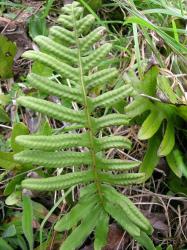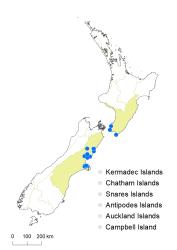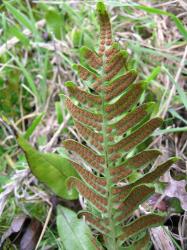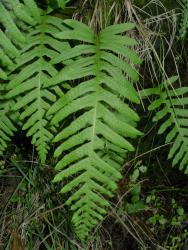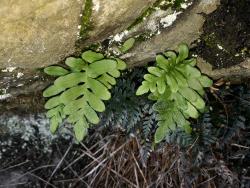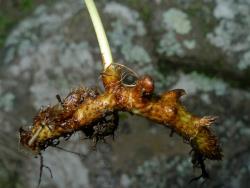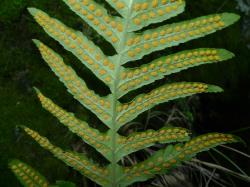Rupestral or terrestrial ferns. Rhizomes long-creeping, 4–7 mm diameter, scaly. Rhizome scales non-clathrate, ovate, 2–6 mm long, 0.5–2 mm wide, squarrose, orange-brown, entire or toothed towards the apex. Fronds 85–550 mm long, or rarely 25 mm long. Stipes 10–250 mm long, not winged except near base of lamina, yellow-brown, glabrous. Laminae 1-pinnatisect, ovate to narrowly elliptic, 55–300 mm long, or rarely 17 mm long, 40–120 mm wide, or rarely 14 mm wide, mid-green turning yellow-green with age, herbaceous to coriaceous, glabrous except for widely scattered scales at base. Pinnae in 2–25 pairs, 10–70 mm long, 3–11 mm wide, oblong, apices obtuse, margins minutely serrate to serrate, decurrent at base, adnate to rachis. Veins free or sometimes reticulate, usually forming 1 series of areoles between costa and lobe margin; hydathodes absent. Sori round or slightly elongate, 1–3.5 mm long, superficial and not or only slightly bulging on adaxial surface, in 1 row on either side of the costa, medial or closer to the costa; paraphyses absent; exindusiate.
Polypodium vulgare is superficially similar to species of Lecanopteris. It can be distinguished by the lamina, at least in its lower third, being divided right to the rachis to form distinct pinnae, whereas in Lecanopteris the lamina is never more than pinnatifid. Also, the pinna margins are minutely serrate, in contrast to the entire margins in Lecanopteris.
It is also very similar to Phlebodium aureum but differs from that species in having each sorus served by a single included veinlet in each areole, rather than two.
North Island: Southern North Island.
South Island: Marlborough, Canterbury.
Altitudinal range: 0–720 m.
Polypodium vulgare was first recorded in New Zealand from the Port Hills of Christchurch (Lovis 1980). It was first observed in the 1960s and is now spreading aggressively in that area, being widespread from Godley Head to Gebbies Pass, on Quail Island, and on parts of Banks Peninsula. More recently it has also been collected from several sites in Canterbury between Christchurch and Kaikōura, as far inland as Hanmer Springs, and from Hongoeka Bay north of Porirua (Shepherd & Perrie 2006) and Cape Palliser (Perrie et al. 2019). It has also been observed in parts of northern Marlborough (see iNaturalist 51455074, 59294091), but not yet collected, and these localities are not recorded on the distribution map. It occurs from near sea level around Wellington, to over 700 m in the North Canterbury hills.
Occurs naturally in Europe, Asia, southern Africa and Kerguelen Island.
On coastal cliffs, road banks, volcanic rock bluffs, and on greywacke rock under dry scrub or shrub or forest vegetation.
Lovis (1980). Voucher: CHR 323300, 1976.
Lovis (1980) determined that plants from the Port Hills were "tetraploid" (i.e. n = 74), but no explicit count was given.
In Europe the Polypodium vulgare aggregate consists of three cytologically and morphologically distinct species. Lovis (1980) concluded that the New Zealand plants were not entirely consistent with any of these three taxa, but that their tetraploid nature and micro-morphological characters suggested they were referable to P. vulgare sens. str. He postulated that they may not have originated from Europe, and southern Africa is a possible alternative source (Perrie et al. 2019). New Zealand plants lack the distinctive gland-tipped paraphyses of the tetraploid American species, P. virginianum.
Polypodium vulgare is a major component of Horny Goat Weed, a Chinese medicine which claims a variety of aphrodisiacal and medical benefits. There is at least one report of deliberate transfer of this species from Christchurch to the Hawke’s Bay region to grow for medicinal purposes. Active control of this aggressive weed is being attempted in the Christchurch area, and deliberate dispersal to other parts of the country is illegal.



